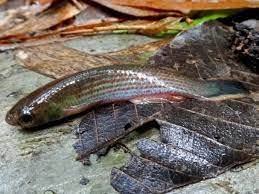Guabine: the fish that jumps out of water

Have you ever seen fish in an isolated pond or even roadside puddles and wondered how they got there?
If you’ve seen fish in these places, one of them may likely have been a jumping guabine (Anablepsoides hartii).
While some fish are displaced by floods during heavy rain, aquatic ecologist Dr Ryan Mohammed told Newsday Kids the jumping guabine often move to isolated places on their own.
If you are confused, Mohammed explained, “It’s not unusual to find these fish in ditches, tyre tracks or even pools at the side of the road because it actually traverses land.
“It is one of the few species of fish that will jump out of water to pursue new pockets of water depending on their needs.”

Growing no more than ten centimetres in length, the jumping guabine has an elongated body which helps with their mobility when they jump.
Mohammed said these fish contort their body like “a spring in a bow and arrow” while jumping and maintain this form as they move across land.
Depending on the temperature and humidity, these fish can survive for several hours out of water. But you may be wondering how so?
“They could respire because there is some exchange of carbon dioxide and oxygen between their skin and the air.
“They also have a thick mucus membrane layer to maintain an interface between the air and their gills.
“Because of the way their eyes are structured and positioned, they also have very good eyesight to see above and below water.”
As expected, jumping guabines are found all across Trinidad but Mohammed said research has shown they are only found on the Atlantic side of Tobago and not on the Caribbean side.
There is ongoing research on why this may be so, and the University of the West Indies MSc biodiversity student Niamh Vaughan is also doing a study comparing the fish found on both sides of Tobago including the jumping guabine.

“The jumping guabine is also only one of the three species of fish that are found in the pitch lake. They are very tolerable to different environmental conditions.”
But Mohammed said there’s still a lot more to be learned about which particular conditions affect the fish’s survival, mortality, and reproduction.
He is currently leading research in this area and also learning more about the relationship between guppies and jumping guabines given the two species are sometimes found co-existing in the same habitats.
However, the co-existence between the two isn’t always harmonious as guppies may eat the eggs of guabines at times and vice versa.
“It’s part competition between the two fish but also because it’s a food source for the guppy which will take and eat anything it can fit in its mouth.”
These fish are usually various shades of brown with reddish stripes about their body. Males have a darker tail, while females have a clearer tail with just a fringe of black at the end. Because of their beauty, they are sold as ornamental pets in some countries where they are found.


Comments
"Guabine: the fish that jumps out of water"